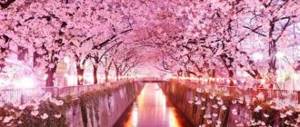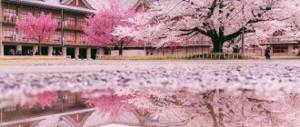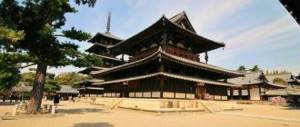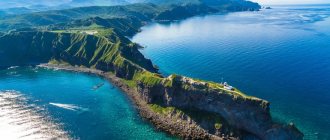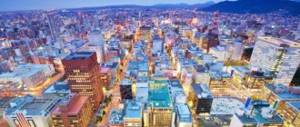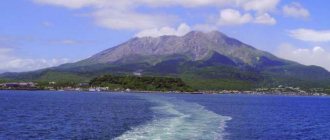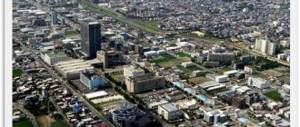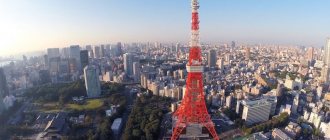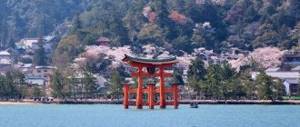Sights of Nara - these are several temple complexes (both Buddhist, “led” by the bronze Buddha in the Todaiji Temple, and Shinto), located in a fairly compact park area against the backdrop of wooded hills.
Nara Park
The park is rightfully considered the main attraction of the city. On its territory there is a national museum and many architectural sites, including the famous Buddhist temples of Todai-ji, Kofuku-ji and the Shinto shrine of Kasuga-taisha.
The park is famous for its beautiful landscapes and tame deer that roam freely and allow themselves to be petted and fed.
Climate
Many tourists wonder why deer are so popular in Japan. The answer lies in an ancient legend. Based on her data, the country's first emperor descended from heaven on deer . In Japanese religion, these animals are considered messengers of the gods. They are honored and respected. In Japan, everyone tries to protect noble animals and create optimal conditions for their existence. Many people feed the deer by hand, pet them and take pictures. Animals do not run away from humans, but on the contrary, they go towards him.
Todai-ji
This is the oldest temple, which is the largest wooden structure in the world. The road to it runs through the Nandaimon gate, guarded by stone demons.
Visitors are amazed by the 15-meter bronze statue of Buddha, as well as the giant columns supporting the arch of the structure. One of them has a special hole called the “Buddha’s nostril”. There is a legend that if a person climbs through it, he will be happy for the rest of his life.
Location: 406-1 Zoshicho.
Yakushi-ji
The monastery was built by order of Emperor Tenmu in 680, whose wife was seriously ill. The wife's miraculous recovery made the monastery popular among pilgrims and those suffering from serious illnesses. Almost all the buildings of the monastery complex were destroyed for various reasons. And only the eastern pagoda has reached us in its original form. Now it is more than 1300 years old. It is considered the oldest wooden building on the planet.
Location: 457 - Nishinokyocho.
NARA
NARA, city in Japan, adm. center of Nara Prefecture. Us. 364.7 thousand people (2012). Located in the south center. parts o. Honshu, approximately 30 km east of Osaka and 35 km south of Kyoto. Junction of railways and roads.
Founded in 710. Until 784 the capital, as well as religious. and the cultural center of Japan, was called. Heijo-kyo. It was built on the model of the capital of China of the Tang Dynasty - Chang'an (now Xi'an): a rectangle in plan (4.8 × 4.3 km), elongated along the north-south axis, with a regular grid of streets. Ch. The highway divided the city into 2 parts: the “right” and “left” capitals. Governments were concentrated in the north. building and the imp was located. castle. In 1180, after an attack by the Taira clan, it was destroyed, but was soon rebuilt. In the 1560s. under the rule of the Matsunaga clan. In 1567, as a result of the confrontation between Matsunaga Hisahide and the Miyoshi clan, it was partially burned and restored again. During the period of the Tokugawa shogunate, the center came under direct control. government. It developed as a center for cotton production, as well as metal processing. Since 1887 the center has the same name. prefectures.
N. is an international tourism center. meanings with plural architectural monuments. Preserved in the Middle Ages. regular planning. The most important monuments include the Todaiji temple complex (“Great Eastern Temple”; 710–784; burned down several times, restored in 1709): Daibutsuden Hall [“Hall of the Great Buddha”; one of the largest trees. buildings in the world; inside is the world's largest bronze statue of Buddha (752; height 16 m), Shosoin (repository of artistic treasures, 8th century), Hokkedo (“Lotus Hall”, 733), Nigatsudo (“Second Month Hall”, 752 , restored after a fire in 1669), Nandaimon Gate (“Great Southern Gate”, 12th century).
Nara. Kofukuji Buddhist Monastery. Tokondo Hall. 1415. Gojunoto Pagoda. 1426.
Also in the city is the Shinto shrine Kasuga-taisha (founded in 709, moved to N. in 768; its architectural design resembles Buddhist temples; the courtyard is decorated with bronze lanterns, the earliest of which date back to the 13th–14th centuries) in a relict Kasugayama Reserve Forest (area 300 hectares), which is adjacent to N. Park, where tame spotted deer (shika), considered the messengers of the gods, live. Buddhist temples: Kofukuji [family temple of the Fujiwara family; 669, moved to modern times. place between 715 and 724; Burnt down 4 times, a number of buildings were restored preserving their original appearance: Hokuendo (“Northern Octagonal Hall”, 721, restored in 1210), Tokondo (“Eastern Main Hall”, 726, restored in 1415), Gojunoto (“Five-tiered pagoda”, 730 , restored in 1426; height 50.1 m), Sanjunoto (“Three-tiered pagoda”, 1143), Nanendo (“South Octagonal Hall”, 813, restored in the late 18th century); next to the temple is the Sarusawa pond (diameter 360 m), Gangoji [718, severely damaged in fires of the 15th and 19th centuries; partially retained the appearance of Ch. hall – Gokurakubo (“Hall of Ultimate Bliss”)], Yakushiji [680, moved to N. in 710–718; condo (main hall, reconstructed in 1970), Toto (“Eastern Pagoda”, 730, height 36 m, one of the oldest wooden buildings in the world), steam room Saito (“Western Pagoda”, burned down in 1528)], Toshodaiji [759; in the Miei hall - wooden. statues of the monk Ganjin and the Thousand-Armed Canon (height 5.5 m) by the whale. masters of the 8th century; The “Kodo Hall” (the hall for reading sermons) was originally an outbuilding of the emperor. palace is now the only building preserved from it]. Nizhny's ancient architectural monuments are included in the World Heritage List. Among modern buildings - Nara-hyakunen-kaikan (“Century Hall”, 1992–98, architect Isozaki Arata).
National n.-i. Institute of Cultural Values (1952). State Universities: Pedagogical. (1888, current status since 1949), female (1908, current status since 1949), Nara Prefecture (1953, current status since 1990); non-state universities: Tezukayama (1964), Nara (1969), agricultural. Faculty of Kinki University (Higashiosaka). Among the museums is the National. N. Museum (founded in 1889, open to visitors in 1895, current status since 1952), Yamato Bunkakan (1960; collection of works of Japanese art), photographs (1992), crafts, calligraphy by Sugioki Kason; artist museums - Neiraku (1969), Nara Prefecture (1973), Nakano (1984), Shohaku (1994), city. Thermal springs of Mikasa (2 km northeast of the center of N.). Botanich. Manyo's garden.
The leading role in the city's economy is played by the service sector: tourism. business (approx. 14 million tourists per year), trade, administration sector. management, as well as software development. Mechanical engineering enterprises (including the production of precision products, pneumatic tools, electronic equipment), chemical. (plastic products, etc.), textile and food industries. Sake production; production of watches and building materials. Woodworking, including traditional. wood production molotov (“shumoku”) for bells of Buddhist monasteries, carved toys. North-west part of N. in the Keihanna Hills area (at the junction of Kyoto, Osaka and Nara prefectures) is included in the so-called. city of science Kansai (1987), including 12 “districts of culture and scientific research” (total area of about 3.6 thousand hectares, population of about 85 thousand people; places of concentration of scientific and scientific institutes, universities, cultural institutions, etc.) and the “peripheral zone” (approx. 11.4 thousand hectares, population over 150 thousand people; auxiliary infrastructure facilities).
11 km southwest of the center of N., in the city of Ikaruga, is the Horyuji monastery complex.
Gango-ji
The once grandiose structure, consisting of 7 halls and pagodas, has survived to this day in the form of several buildings. Of these, the best preserved are the Zen room, the main hall of Hondo and the miniature pagoda, whose height is just over 5 meters. All listed objects are included in the list of National Treasures.
Location: .
Saidai-ji
Previously, the complex occupied an area of about 50 hectares and consisted of more than 100 buildings, of which only a few have survived. It gained popularity among residents and tourists thanks to its unique tea ceremony. Anyone can take part in the tea party. Its peculiarity is that tea is served in huge cups weighing up to 7 kg.
How to get there
Nara does not have its own airport, and most visitors arrive at Kansai International Airport, or Osaka International Airport, which is more geared toward charter flights.
From Kansai Airport to both Nara train stations, Limousine Buses operate every hour (1 hour 30 minutes, 2050 JPY). An alternative option if you have a Jayaru (Japan Railways) pass: take the Haruka express train to Tennoji Station, then transfer to the Yamatoji Line train to Nara (1 hour 15 minutes, 2360 JPY). Otherwise, it is cheaper to take the Nankai Line express train to Shin-Imamiya Station, from where the Yamatoji Line train goes to Nara (1 hour 30 minutes, about 2000 JPY).
Find cheap flights to Nara
By train
From Kyoto to Nara, trains run on the Nara Line of Japan Railways and the Kyoto Line of the private Kintetsu Railway Company. Moreover, Nara Kintetsu Station is located more conveniently than Nara Station of Japan Railways. Limited express trains, or so-called tokkyu (operated by the Kintetsu Railway Company), depart from Kyoto twice an hour and reach Nara in 35 minutes. Slower but more frequent express trains, or kyuko, reach Nara in 50 minutes (sometimes requiring a transfer at Yamato-Saidaiji Station). The trip will cost 620 JPY plus 510 JPY on top of which you will need to pay for travel to the tokkyu. Jayaru pass holders can use the Miyakoji train (45 min, 710 JPY).
The fastest way to get to Nara from Osaka is to take the Nara Kintetsu Line train from Namba Station. Kaishoku-kyuko trains (something between a fast and an express train) run three times an hour and arrive at Nara Kintetsu Station (40 min., 560 JPY). Jayaru pass holders can take the Yamatoji-kaisoku fast train from Osaka Station, Tennoji Station and intermediate stations on the Osaka Circle Line. The journey from Osaka Station takes 45 minutes. and will cost 800 JPY, from Tennoji station - 30 minutes. and will cost 470 JPY.
The private Hanshin Railway operates the Namba Line from Kobe (Sannomiya Station) to Nara Kintetsu Station (90 min, 970 JPY). Direct kaishoku-kyuko trains depart three times an hour, otherwise you must change trains at Amagasaki.
When traveling between Kyoto, Nara and Osaka, consider purchasing a Kansai Pass, which allows unlimited travel for 2 or 3 days on private train lines, buses and subways (excludes Japan Railways) in the Kansai region.
Nara
By bus
Since the attractions of Nara are very popular among travelers, there are a large number of bus routes between Nara and other cities throughout Japan, the use of which allows you to significantly save on transport.
Buses from several companies run from Tokyo to Nara (travel time 7-8 hours) - these are Japan Railways buses (from 8800 JPY) and Nara Kotsu buses (from 5980 JPY).
In addition, the budget operator Willer Express organizes connections to Kyoto, from where you can travel to Nara by train. The advantage of Willer Express is that you can buy a bus ticket online, and the pass is valid on all company routes with a couple of exceptions.
Horyu-ji
The religious complex is a 12-minute drive from the city. Like all the Seven Great Temples, it is filled with an atmosphere of oriental originality. Its main value is that almost all the buildings have reached us in their original form. Unlike its six brothers, the structure gives the impression of an airy and light structure.
Location: 1-1 Horyuji Sannai, Ikoma District.
Kasuga-taisha
A Shinto shrine whose main buildings are painted bright red. A special feature of this historical monument is the huge number of different lanterns located on its territory. They are lit during two holidays in February and August. Next door is the beautiful Manyoshu Botanical Garden.
Location: 160 - Kasuganocho.
Seasons in Nara
From soaking in hot springs in winter to participating in fun festivals in summer, each season has its own unique adventures. Find out what each season has to offer.
Spring
Known for having some of the most beautiful cherry blossoms in the country, the city has always been a popular destination among Japanese in the spring. But that’s not all: from late February to early July, peonies, hydrangeas, rhododendrons and other seasonal flowers grow and bloom in parks, gardens and on temple grounds.
Summer
Blessed with centuries-old forests, cedar-strewn shrines, and lush green mountain areas, Nara provides plenty of opportunities to escape the often oppressive summer heat of Japan's built-up areas. This is an ideal time for hiking and camping, and is also a great opportunity to attend one of the local festivals and fireworks displays. Many temples and shrines also hold magical illuminations, during which candles and lanterns are lit.
Autumn
In autumn the weather cools down, making hiking more comfortable. From mountains to world heritage pilgrimage routes, there is no shortage of hikes here. Like spring, autumn is also known for its amazing views: rice fields turn golden in color and tree leaves, especially in Nara Park and around shrines and temples, glow in bright red and yellow hues.
Winter
Traditionally the "off-season" for Japanese tourists, Nara is quietest in winter. With fewer visitors, museums, temples and World Heritage sites allow for more intimate experiences. Michelin-starred restaurants are easier to book, and ryokan accommodations tend to be more affordable. Whether you want to relax at a hot springs resort or explore the back streets of Naramachi and Imaicho, winter is all about slow-moving interactions with the locals.
National Museum
This is one of the oldest museums in the country. The main exhibitions are dedicated to Japanese art. The exhibits include statues of gods, paintings, manuscripts, and bronze vessels. In 1980, a library of Buddhist art was opened in one of the premises.
You should definitely visit the underground corridor connecting the East and West wings of the museum, and the tea house located in the courtyard.
Ancient capital
The city of Nara appeared in Japan not by chance. Capitals in ancient times moved along with the government. The seers believed that the previous center was founded in the wrong place. Therefore, there was no prosperity and prosperity in the country. In 708, construction began on the Nara cultural center . At the same time, the architects took into account all the instructions of the Feng Shui masters and seers. In 710, the emperor moved to the city and for 74 years Nara was the seat of government. In 784, the capital was moved to the city of Nagaoka, but Nara remained the religious and historical center of the country.
Isuyen Garden
The traditional Japanese style garden is located in Nara Park. It occupies an area of more than 13 thousand m2, on which several picturesque reservoirs are located among lush greenery.
On two islands in the central pond there are figures of a turtle and a crane, which are considered symbols of Japanese longevity. The garden paths lead to wonderful tea houses. Since 1969, the Museum of Ceramics has been operating on its territory, the collection of which includes more than 2 thousand exhibits.
Location, population
Nara is located on the island of Honshu , but it is landlocked, as it is surrounded on all sides by other administrative units. This is the region of Kinki , Kii Peninsula. The prefecture of “deer city” is the smallest in all of Japan. It ranks 40th in area in the country.
The Ikoma Mountains border the city of Osaka to the northwest. The most populated place in the prefecture is the Nara Depression. Most of the territory of this administrative unit is occupied by mountains, hills and rocks.
The city is located next to modern Kyoto. However, Kyoto is a metropolis with a bustling noisy life, and Nara is a measured small town. The population of the “reindeer settlement” is about 1,500,000 people. Buddhism and Confucianism are preached here.
The peninsula is influenced by a subtropical climate. The lowest temperatures were recorded in winter (-3-5 degrees), and the highest in summer (26-28 degrees). There is little snow here, and in summer there is a lot of precipitation. In spring you can see the cherry blossom gardens blooming. Hundreds of tourists come to see this beautiful natural phenomenon.
